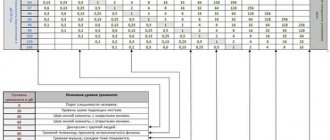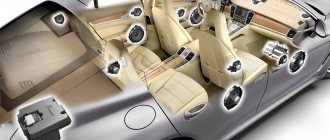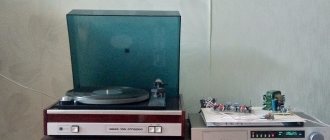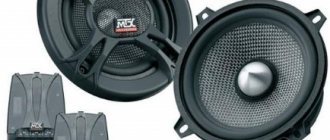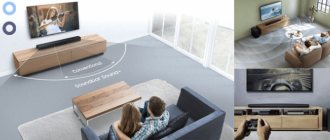Even if we assume that not all car owners are music lovers, the number of those who are not satisfied with the sound quality of a standard car radio is quite large.
Having realized the need to replace it with high-quality reproduction equipment, many are faced with a dilemma, which again comes down to the price/quality ratio. Simply put, they have a difficult choice between coaxial and component acoustics.
In search of the “right” choice, you can pore over specialized literature for months, study the principles of constructing such systems, and ultimately come to the conclusion that it would be easier to consider the advantages and disadvantages of each of the systems, their features and differences, and based on this make a final decision. This is exactly what we will do now.
What is coaxial acoustics?
Roughly speaking, this is one or more speakers connected into a common structure, but “broadcasting” at different frequencies.
The simplest and most affordable option is a regular broadband speaker. The coaxial speaker has expanded capabilities in terms of sound - it covers a wider range of reproduction of acoustic signals.
Let's consider the design features of a coaxial type acoustic system:
- combining several speakers in one housing;
- reproduction of different frequency sounds is achieved by dividing the signal into areas;
- To carry out such a breakdown of the signal coming to the speaker from the “head”, a crossover is used. It can be located in a separate case or be a regular capacitor (this solution is used in budget models).
However, a crossover, which is a type of capacitor-inductance circuit, is used with equal success in component acoustics along with coaxial ones. Its task, as you understand, is to distribute the entire spectrum of audio frequencies into separate audio channels or tracks.
Choosing the right system components will have a huge impact on your sound quality, so be sure to do your research carefully.
The main advantage of coaxial acoustics is the ability to create a decent-sounding system while spending modest money. In addition, installation of such a circuit usually does not cause difficulties if all work is carried out step by step in accordance with the following simple algorithm:
- We install the purchased acoustic equipment in its original location;
- We connect the speakers to the car radio or, alternatively, to an amplifier.
Compared to standard acoustics, coaxial will be a noticeable step forward. But it is still far from high-quality acoustic systems, and there is no way to reach it - a single speaker is simply not able to reproduce the entire spectrum of frequencies, mixing of frequencies occurs, this phenomenon cannot be avoided, and the sound quality suffers.
Canton Chrono 503.2
The best component acoustics in a car
Chrono 503.2 is a real German speaker: excellent workmanship, 100% quality control of each copy, Made in Germany. Despite the stated glossy finish, the speaker is covered with film, and only the front panel is made glossy. The size of the speaker is not very large, but the speaker managed to accommodate an impressive 180 mm. Of course, it is equipped with the traditional Canton aluminum diffuser. The suspension is made in the shape of a wave for the most linear and long piston stroke of the diffuser. The 25mm tweeter dome is made from a very lightweight but durable aluminum and magnesium alloy. For reliability, it is protected by a metal grill. There are two threaded holes on the bottom for mounting on a stand or bracket.
Bookshelf speakers Canton Chrono 503.2
SoundThe musical material is presented very carefully. The frequency balance is almost perfect. The timbres of instruments are transmitted with high reliability, and small details are not lost sight of. There is no increased emotionality, but thanks to a wide and smooth dynamic range, the speakers manage to accurately convey the musical idea of the composition. The bass is collected, neat, exactly in its place. However, it is not very deep, and at low volumes it loses its position even more. At first it seems that there are too many high frequencies, but they appear exactly when you really need them, and in the right quantities. The upper register is very clean, which fans of modern electronic music will certainly appreciate.
Measurements
The frequency response is smooth, although it depends quite strongly on the listening angle - the directivity of the speakers is relatively narrow. The THD is very low and there is good headroom at low frequencies. Impedance is unstable.
Component acoustics
A component speaker system, as the name suggests, consists of many components, with each speaker specialized in reproducing a specific frequency range, requiring connection to a separate channel of the amplifier/car radio.
In such a speaker system, all components work as smoothly as possible, without interfering with each other.
But quality comes at a price:
- high cost of equipment;
- increased requirements for the radio, that is, again, you will have to spend money;
- complexity of installation (to put together such a system yourself, you will have to thoroughly prepare by sifting through a mountain of material on the Internet);
- you will have to worry about installing additional soundproofing materials in the cabin.
Wharfedale Jade 3
The British company Wharfedale traditionally spares neither effort nor materials even on budget lines. And the Jade 3 model once again confirms this. In our test, this is the largest and heaviest shelf speaker, and the only 3-way one. A body with curved walls is a feature of the top lines of many other manufacturers, but not Wharfedale. Both the body shape and the additional bulkheads make the body as acoustically inert as possible, preventing unwanted sound coloration. High frequencies are handled by an aluminum dome tweeter. At the border of 3 kHz it is replaced by a midrange speaker with a diffuser made of aluminum-cellulose composite. And already in the region of 350 Hz, the initiative is seized by the woofer, equipped with a woven diffuser made of a mixture of carbon and fiberglass. The combination of such materials with a braided structure brings the diffuser closer to an ideal piston, eliminating the problematic resonance phenomena inherent in metal diffusers.
Bookshelf speakers Wharfedale Jade 3
The speakers operate in a closed volume. The crossover for the speaker was optimized on a computer for maximum linearity of signal phase transmission.
Sound Wharfedale speakers sound traditionally beautiful. All instruments are clearly arranged spatially. The music stage is clean and spacious.
The speakers deliver bass carefully, not forcefully, as if they are afraid of damaging the balance of the overall sound picture. The same can be said about upper case.
The softness of the presentation of musical material is interestingly and harmoniously combined with excellent sound detail. In addition, the speakers play very well at low volumes.
Measurements
The frequency response of the model is flat, but at high frequencies it behaves in a peculiar way - a decline and a sharp rise. The bass is deep. The SOI is almost perfectly flat and extremely low. Very solid headroom for low frequencies. The impedance is quite stable.
Difference between coaxial and component systems
Having looked at the main features of the two types of systems, let's take a closer look at what the difference is between component and coaxial acoustics.
All design and other differences are divided into several subtypes:
- Location of speakers in the car. In coaxial systems, sound transmission is highly directional, so the speakers are usually mounted on a shelf located behind the rear row of seats. The component system is characterized by surround sound, and such multidirectional sound waves propagate well throughout the cabin, which is why they are often installed in the front of the car. But since all speakers have different frequency characteristics, achieving the ideal sound will require careful acoustic tuning. But there is no point in installing component sound on small compact cars - you will not notice a difference in sound due to the small space, which is insufficient for the dispersion of sound waves.
- The presence of a crossover. As a rule, this component is present in both types of devices, but in coaxial systems the crossover is hidden inside the speaker, and in component systems it is an external device that requires additional installation space.
- Installation features. What makes coaxial speakers different from component ones is the complexity of installation. Of course, in both cases you will be required to have the appropriate knowledge and skills. Thus, when installing component acoustics, a necessary condition is the correct placement of the speakers, taking into account the presence of different sound zones. Most likely, additional sound insulation of the interior will be required. You need to understand these issues, and if this is a “dark forest” for you, it is better to turn to specialists. Another thing is the coaxial system. Everything is much simpler here; speakers are usually installed at the rear, while most models offered in retail have dimensions and a shape suitable for installation in standard places.
- System price. For many, the difference in cost between coaxial and component speakers is the main factor determining their choice. Their argument is simple: the difference in sound quality is not as important as it is for hardcore audiophiles, so why pay through the nose if the sound is still not ideal in a moving car due to extraneous interference.
The loudspeaker is a group emitter.
About the design and operation of the car What is better than Lada Priora or 2112. What is better than VAZ2112 or Priora. Calculations and miscalculations
A group emitter is a set of similar dynamic heads placed in the same plane at a certain distance from each other and connected to each other in phase, series or parallel, or series-parallel. To ensure good performance of a group radiator loudspeaker, it is necessary that all heads are of the same type and the same power is supplied to each head. Failure to comply with these requirements or disruption of the in-phase operation of the heads reduces the efficiency of the group emitter.
The widespread use of loudspeakers of this type abroad is due to several reasons. The first is that using several low power heads you can create a high power loudspeaker. Thus, a Swedish amateur radio magazine published descriptions of amateur loudspeakers containing up to 6-8 similar broadband heads of 20 W each. Such speakers can work with amplifiers with output power up to 100-200 W.
Another reason for the proliferation of group emitters is their inherent improvement in output at medium and especially the lowest frequencies. This improvement is due to an increase in the opening area of the diffusers, proportional to the number of heads. At the lowest frequencies, this increase is 6 dB for four heads, 8 dB for six and 9 dB for eight. Due to this, the bandwidth of effectively reproduced frequencies is expanded into the region of lower frequencies by about a third or half an octave compared to the bandwidth of a single head in the same design.
The third reason is that the depth of the cabinet box of such a loudspeaker can be 1.5-2 times less than a loudspeaker with a single head, i.e. the group emitter can be quite flat and can be placed on the floor near a wall or even hung on wall.
Let us dwell on two design options for a group radiator type loudspeaker containing four dynamic heads of 6 W each. In these loudspeakers it is most convenient to use low-frequency drivers of the 6GD-2 type. When the hole diameters are reduced, it is possible to use heads like 4GD-4 or 4GD-7, 4GD-av. 4GD-35, 4GD-36. Preference should be given to the first and last two heads.
The design of the housings of both options is shown in Fig. 3,a,b. The housings are made of chipboard 20 mm thick. The parts are assembled using screws and glue. The difference between the options lies in the shape of the front wall: in Fig. 3, and it is flat, in Fig. 3.6 - slightly folded in the middle. Both designs have approximately the same characteristics in the low-frequency region. The results of the calculations carried out by the author are shown in Fig. 4, from which it can be seen that a noticeable increase in the output of the heads with a distance between the centers of their diffusers equal to 260 mm is observed starting from a signal frequency below 600 Hz.
The main advantage of a loudspeaker with a broken front panel (Fig. 3, b) is a slightly better uniformity of radiation at mid and high frequencies in both planes. In a loudspeaker with a flat front panel (Fig. 3a), on the contrary, the radiation pattern at these frequencies narrows.
Group radiators have been widely used recently; they are often used as low-frequency radiators in systems with several signal frequency division bands. Such systems, designed for input power up to 50-100 W or more, are widely used for sound stages, dance halls and discos.
Foreign amateur radio designs. Moscow, Radio and Communications, 1982.
The acoustics we live with → ← The best is the friend of the good
Magnat Quantum 753
The speaker from Magnat's mid-priced Quantum 750 line looks solid. The front wall is made thick (40 mm) to radically combat body resonances. A solid 30 mm thick podium also emphasizes the solidity of the structure. It is curious that the front panel and podium are polished to a shine, while the rest of the surface of the case is matte. The F-max tweeter is equipped with a dome made of a double textile compound and has an extended operating frequency range. The midrange/bass speaker diffuser is made of ceramic/aluminum. The voice coil is well ventilated. The aluminum speaker basket design is optimized for optimal airflow and reduced resonances.
Bookshelf speakers Magnat Quantum 753
The bass reflex port with a large horn is located on the rear wall. The crossover is optimized for signal phase and amplitude and is assembled from selected high-quality elements.
Sound The speakers play emotionally, dynamically, quickly. At the same time, the timbres of instruments are perfectly conveyed, and the musical scene is not obscured by extraneous sounds - they are pure and deep. Sound source localization is excellent. The detailing is also at a high level.
The HF level is enough for an open sound with the presence of airiness, and at the same time the upper register is very neat and unobtrusive.
Bass of medium depth, collected and fast. There is a little lack of physicality and density of presentation. At low volumes, the enthusiasm of the speakers is lost, the emotionality fades.
Measurements
The unevenness of the frequency response is minimal, but the frequency imbalance towards the HF is obvious. The SOI varies within 1% and noticeably depends on the volume, but no obvious resonances are noted. Good SOI margin at low frequencies. Impedance is unstable.
The loudspeaker is an organ pipe.
High requirements for the quality of operation of an acoustic installation, on the one hand, and the limited area of living space where loudspeakers can be placed, on the other, force designers to look for solutions that meet these requirements, or to find an acceptable compromise. In this regard, the design of a single-way loudspeaker with two broadband dynamic heads connected in phase, in series, is of particular interest. The loudspeaker is described in American amateur radio literature. Sketches of its front panel and cross section are shown in Fig. 2.
The described acoustic design has a body in the form of a column with a cross section of 200x200 mm, a height of 800 mm with two slots at the base formed between the floor and the side walls shortened by 26 mm, as shown in Fig. 2. At the top of the case there are two holes for installing dynamic heads on the front and rear walls of the case. The dimensions of the cutout and the characteristics of the heads allow the use of domestic dynamic heads of the ZGD-38 type in this design. The walls of the housing are made of plywood or chipboard with a thickness of about 15 mm.
The elongated shape of the loudspeaker housing and the small floor area occupied by it allow the use of such loudspeakers in stereo and quad-raphonic installations. In addition, the loudspeaker of the described design is characterized by improved low-frequency response and an expanded radiation pattern in the horizontal plane.
The first advantage is due to the phenomenon of standing waves observed inside the loudspeaker cabinet, which behaves like an organ pipe tuned to a frequency of about 100 Hz. It is at this frequency that one quarter of the wave is laid along the speaker body, which contributes to the rise of the lower frequencies. At a frequency twice as high, equal to 200 Hz, on the contrary, exactly half the wavelength fits along the length of the body. At the same time, suppression of radiation from the lower part of the body is observed, which eliminates the unpleasant booming sound characteristic of acoustic installations with large linear dimensions.
The second advantage is associated with the use of two heads emitting in opposite directions. By changing the direction of the speakers' emissions by rotating them relative to their longitudinal axis, you can achieve the best sound reproduction in a particular room. At the same time, one should not regret that half of the emitted power is directed in the opposite direction relative to the listener. Low and mid frequencies, reflected from walls and furniture, produce multiple re-emissions of sound, as if blurring the small size of the sound sources themselves and creating the impression of spatial sound.
Triangle Color Bookshelf
Very nice-looking speakers from the French manufacturer Triangle are available in three lacquer colors - white, black and red. The Color line stands out with its bright, cheerful style among all Triangle products and takes its place as the entry-level line.
The bookshelf model uses a tweeter with a titanium membrane and a midrange/woofer with a paper cone. In general, the speaker is quite interesting; its suspension is wide, corrugated and basically made of fabric. The paper diffuser is coated with a special compound. The dust cap is designed in the shape of a bullet. The design of the crossover uses developments from the top Magellan line. The bass reflex port is located on the rear wall of the speaker.
Bookshelf acoustics Triangle Color Bookshelf

